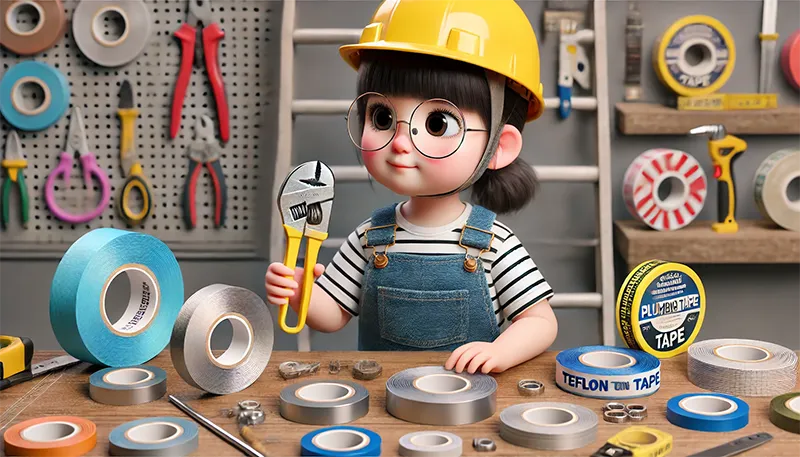A small roll of plumbing tape can save you from major leaks and costly repairs—but only if you choose the right one.
Plumbing tape, often overlooked, is a key tool for ensuring leak-free connections in plumbing, gas, and industrial applications. With various types available, understanding which one fits your needs is essential.
In this guide, we’ll explore the types of plumbing tape, their uses, and how to choose the best plumbing tape for your project. Let’s get started!
Why Plumbing Tape is Essential
Plumbing tape, also known as thread seal tape or PTFE tape, is a thin material used to seal threaded pipe connections. It prevents leaks by filling gaps between threads, creating a tight seal. Without it, even the most carefully assembled pipes could leak under pressure.
Key Benefits:
- Prevents leaks and ensures a watertight or airtight connection.
- Reduces friction between threads, making it easier to tighten connections.
- Protects threads from corrosion and wear.
Plumbing tape is a must-have for DIY enthusiasts and professionals alike, with applications ranging from simple household fixes to high-pressure industrial systems.
Types of Plumbing Tape
PTFE (Teflon) Tape
The most common type of plumbing tape, PTFE tape is lightweight, non-adhesive, and highly effective for sealing threaded pipe connections.
Variants and Their Uses:
- White: Standard PTFE tape for general plumbing applications, such as water and air pipes.
- Yellow: Thicker PTFE tape specifically for gas lines.
- Pink: Heavy-duty PTFE tape designed for water lines.
- Green: Non-reactive tape for oxygen and medical gas lines.
- Gray: Anti-seize PTFE tape for stainless steel pipes, preventing thread galling.
High-Density PTFE Tape
Thicker and denser than standard PTFE tape, high-density tape is ideal for industrial and high-pressure applications. It provides added durability and a more robust seal.
Silicone Tape
Silicone tape, also called self-fusing tape, is an adhesive-free material that bonds to itself when stretched and applied under tension.
Best For:
- Emergency plumbing repairs.
- Sealing irregular or damaged surfaces.
- High-pressure and high-temperature systems.
How to Choose the Right Plumbing Tape
Step 1: Identify the Pipe Material
- For metal pipes, consider gray PTFE tape to prevent galling.
- For plastic pipes, ensure the tape is compatible with non-metal materials.
Step 2: Determine the Application
- Water lines: Use white or pink PTFE tape.
- Gas lines: Always use yellow PTFE tape for safety and compliance.
- Oxygen or medical gas lines: Opt for green PTFE tape.
Step 3: Consider Pressure and Temperature
- For high-pressure or high-temperature systems, choose high-density PTFE tape or silicone tape for better performance.
Step 4: Check for Certifications
- For potable water systems, ensure the tape is certified safe for drinking water applications. Blue PTFE tape is often used for this purpose.
Top Tips for Using Plumbing Tape Effectively
- Clean the Threads
Remove debris, dirt, or old tape from the threads before applying new tape. This ensures a clean surface for a tight seal. - Wrap the Tape Clockwise
Always wrap the tape in the direction of the threads (clockwise). This prevents the tape from unraveling as you tighten the connection. - Use the Right Number of Wraps
For most applications, 2-4 wraps of tape are sufficient. Larger pipes or high-pressure systems may require additional layers. - Avoid Over-Tightening
While a snug connection is necessary, over-tightening can damage threads and compromise the seal.
FAQs
-
What is the difference between PTFE and Teflon tape?
PTFE refers to the material used, while Teflon is a brand name for PTFE tape.
-
Can I use the same tape for gas and water lines?
No, always use yellow PTFE tape for gas lines and pink or white tape for water lines to ensure safety and proper sealing.
-
How long does plumbing tape last?
Properly applied tape can last as long as the connection remains sealed. If a connection is undone, replace the tape.
-
Is silicone tape permanent?
No, silicone tape is a temporary solution meant for emergency fixes. It should be replaced with a permanent seal when possible.
-
Can I reuse plumbing tape?
No, always use fresh tape for a secure seal when reassembling fittings.
Finally, What The Best Plumbing Tape?
Choosing the best plumbing tape for your project ensures leak-free and durable connections. PTFE tape is versatile and essential for threaded connections, while silicone tape excels in emergency and high-pressure scenarios.
By understanding the specific needs of your project—pipe material, application type, and pressure requirements—you can select the ideal tape with confidence.
Keep a variety of plumbing tapes in your toolkit to handle any situation, and always apply them correctly for the best results. A small roll of the right tape can save you big headaches in the long run!



